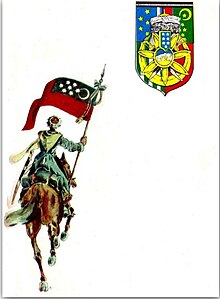Kaukasisch-Mohammedanische Legion

The Caucasian-Mohammedan Legion (German: Kaukasisch-Mohammedanische Legion) was a volunteer unit of the German Army. The Legion was created on January 13, 1942[1] by order of General Infantria Olbricht. The Legion consisted of Abkhazians, Circassians, Balkars, Karachais, Chechens, Ingushes, and the peoples of Daghestan. The Kurds, Talyshs and Ossetians appeared later. In accordance with the decree of February 19, 1942, volunteers from the peoples of the North Caucasus were August 2, 1942 allocated on a national-territorial basis separately to the North Caucasian Legion / Mountain-Caucasian Legion. The initial placement of the Legion was Wesel.
History[]


In October 1941, one for each of the Turkestan and Caucasian prisoners of war (the operation of the Abwehr "Tiger B") was created for the special purposes of Abwehr and controlled by the (in June 1941, it consisted of 21 Abwehr commandos, at least 70 Abwehrgroups and many sabotage-intelligence schools) and subordinated to the two officers of the Abwehr, and Theodor Oberländer. Professor Oberleutnant Oberländer was the Head of the Department of Social Sciences department in Königsberg, Greifswald and Prague before the war. Oberleutnant Oberländer was also the political leader of the Nachtigall Battalion.
Caucasian-Mohammedan Legion was created on 13 January 1942 by order of General Olbricht, commander of the reserve army. For this purpose, a German training headquarters was established, headed by Major Andreas Meier Mader. He was assigned the task of replenishing the 7 companies of the respective nationalities created by prisoners of war before that. Suitable prisoners of war were to be checked, released from captivity, and after a short trial period, dressed in German uniform. On the basis of the Mayer-Mader union, it was allowed to form the Caucasian-Mohammedan and Turkestan legions. On the 19 February, the chief of armaments and the commander of the reserve army ordered the Caucasian-Mohammedan and Turkestan legions were separated. On 2 August 1942, the representatives of the Caucasian peoples were consolidated into a separate North Caucasian legion. The Legion consisted of Abkhazians, Circassians, Balkars, Karachais, Chechens, Ingushes, and the peoples of Daghestan. The Kurds, Talyshs and North Ossetians appeared later.
In 1943 the headquarters of the North Caucasian Legion was created in the town of Mirgorod of Poltava region under command of Lt. Col. Ristov. In the summer of 1944, the formation of the North Caucasian and Caucasian SS regiments began on the basis of 70 and 71 police battalions. At the end of the war in Northern Italy, the North Caucasian combat group joined the . The commander of the Standard Army of the SS, a former officer of the White Army , joined the regiment as a regiment.
In addition to the reinforced 9 field battalions,1 battalion of the Sonderverband "Bergmann" (Special Unit "Miner") of the and one combat group of , the natives of the North Caucasus were part of a separate Sonderkommando Schamil consisting of three groups of forces up to a platoon, three sapper, railway and road-building companies, as well as two serf regiments. According to the researcher Traho R. "The total number of North Caucasian volunteers since the beginning of the war against the USSR and until 1945 amounted to 28-30 thousand people".
See also[]
References[]
- ^ Motadel, David (2014-11-30). Islam and Nazi Germany's War. ISBN 9780674724600.
Sources[]
- Napso, N. T. (2006). "Severokavkazskie voinskie formirovanii͡a v germanskikh vooruzhennykh silakh (1941-1945 gg.)" Северокавказские воинские формирования в германских вооруженных силах (1941-1945 гг.) [North Caucasian military units in the German armed forces (1941-1945)]. Bulletin of the Adyghe State University (in Russian) (4): 20–24.
- Pahl, Magnus (17 January 2013). Fremde Heere Ost: Hitlers militärische Feindaufklärung. ISBN 9783862842032.
- Kuromiya, Hiroaki; Mamoulia, Georges (25 April 2016). The Eurasian Triangle: Russia, the Caucasus and Japan, 1904-1945. ISBN 9783110469592.
- Reveron, Derek S.; Murer, Jeffrey Stevenson (13 May 2013). Flashpoints in the War on Terrorism. ISBN 978-1135449247.
- Motadel, David (30 November 2014). Islam and Nazi Germany's War. ISBN 9780674744950.
- Motadel, David (Winter 2015). "The Swastika and the Crescent". The Wilson Quarterly.
- Höpp, Gerhard; Reinwald, Brigitte, eds. (2000). Fremdeinsätze. Afrikaner und Asiaten in europäischen Kriegen, 1914–1945 [External assignments. Africans and Asians in European Wars, 1914–1945] (in German). Verlag Das Arabische Buch.
- Foreign volunteer units of the Wehrmacht
- Peoples of the Caucasus
- History of the Caucasus